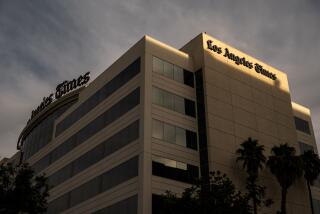Journal of the French Left : Le Monde: Broke, No Longer Chic
- Share via
PARIS — Le Monde--gray, discursive and verbose--is the most influential newspaper in France. No other French newspaper, in fact, commands as much respect in the rest of the world. But in Paris these days, it is chic to say that you do not read Le Monde anymore.
The most fashionable newspaper to hold under your arm now is the tabloid Liberation, which is brassy, irreverent and concise. Professionals with a working knowledge of English boast that they would rather read the International Herald Tribune, the American newspaper published in Paris, than Le Monde.
That point is underscored in the current trendy movie, “Rive Droite, Rive Gauche.” In a significant scene, French actor Gerard Depardieu, playing a rich young Parisian lawyer, peeks over his newspaper in a hotel lobby to catch a glimpse of actress Nathalie Baye. He is reading the Herald Tribune, not Le Monde.
Financial Hemorrhage
Le Monde has been hurt badly by this change in taste. Circulation is dwindling, intensifying the hemorrhage of financial losses. While theories about the deeper causes of the problem abound, no one can agree on a solution.
Director Andre Laurens, whose equivalent on an American newspaper would be a combined publisher and editor, has been forced to resign. The workers own the newspaper, yet in a fit of pique, they recently went on strike for two days.
Still, many trend-setters like to have Le Monde around. Asked about the Parisian penchant for belittling the newspaper, an editor on the French news magazine L’Express said at a recent lunch: “Oh, I say that, too. But on those two days that Le Monde was on strike, I missed it.”
Anti-Le Mondism
Many other French are willing to do without Le Monde, which was created 40 years ago by aides of Gen. Charles de Gaulle looking for ways to rebuild French prestige after the disasters of defeat, occupation and collaboration in World War II. The current mood of anti-Le Mondism raises serious questions about how much longer France’s best-known newspaper will be around.
The crisis came to a head in November when the editors, staff and other employees rejected a plan by director Laurens to pull Le Monde out of its financial troubles. Five years ago, its daily circulation was at a high of 445,000, a figure that has since fallen to 370,000. The loss for 1984 was estimated at $3.5 million, bringing the total to more than $8 million in the last three years.
These statistics need to be put in perspective. Despite the loss of readers, Le Monde still contends with France-Soir for the distinction of having the highest circulation in Paris. Its advertising revenue is still second only to that of Le Figaro, another respected paper favored especially for its coverage of the arts.
Also, few papers in France make a profit. Most could not exist without government subsidies in the form of cheap newsprint, low postal rates, tax breaks and loans. At Le Monde, however, a kind of panic seems to have set in--perhaps out of fear that an irreversible trend may have been set in motion.
Laurens proposed cutting salaries by 14%, selling the old, baroque building that houses the newspaper, putting one of the printing presses in mothballs, and printing regional editions by facsimile in smaller, tabloid size.
The staff went out on strike against the plan and then voted to reject it.
The vote, which forced Laurens to resign, may actually have turned more on an appraisal of his leadership than of his plan. Laurens, 49 and quiet-spoken, had come out of the middle ranks of the newspaper to take over in June, 1982, as a compromise candidate after a bitter battle between what were known as the “Third World” and the “anti-Soviet” groups on the newspaper.
Andre Fontaine, 63, a diplomatic correspondent who failed twice before to win the director’s job, has now been asked to prepare a new management team and a salvage plan for the newspaper. Once he does so, the staff is expected to name him director.
Analysts have come up with myriad reasons to explain Le Monde’s troubles, ranging from the sociological and psychological--some say you cannot expect a group of intellectuals to know how to manage a newspaper--to the technical.
Some say that Le Monde is simply facing the fate of most afternoon newspapers worldwide. Others insist that after acting as kind of a leftist opposition for so many years, Le Monde has lost a sense of purpose, now that the leftists are in power in France. Overstaffing and bloated salaries are also cited as problems.
But the most telling and most common criticism is that Le Monde is simply dull and out of date. Most of its front page is taken up each day with meandering articles that attempt to analyze the significant news events of the day or week. At times these articles have clarity, a point of view, sharpness. But more often they do not.
The analyses are written with an air of authority and significance, but a reader often reaches the end finding that, at heart, there was nothing authoritative or significant in them at all. It can be a frustrating experience.
Le Monde looks especially out of date at a time when many leaders in France, from President Francois Mitterrand down, are talking about the need for modernization, efficiency and directness.
Liberation, a sloppier newspaper than Le Monde with less background and documentation and fewer texts of speeches and interviews, nonetheless seems to fit this sharper mold better than Le Monde. Liberation likes to focus on the main news story of the day, with five or six tabloid pages of news, pointed analysis, background, human interest, photos and maps. In an era of pro-Americanism, Liberation’s headlines ring with phrases in English. Its pages bristle with wit and irreverence.
At 120,000, the circulation of Liberation is far behind that of Le Monde, but the newspaper is growing and, more important, it seems fashionable. Mitterrand recognized that last May, when he granted an interview summing up his first three years in office to Liberation editor Serge July. It was the kind of interview that Le Monde, by tradition, should have had.
Le Monde emerged in 1944, out of the ashes of the prewar Paris newspaper Le Temps. Before the war, Le Temps had been regarded outside France as the unofficial spokesman for the French government. During the war, Le Temps moved from Paris to Lyon after the Germans occupied Paris and northern France.
Its record of sympathy for the collaborationist Vichy government of Marshal Philippe Petain was no worse than that of other papers, but the followers of De Gaulle resented its role even more because its international reputation had lent prestige to Petain.
After the liberation of France, the first De Gaulle administration--which held power until January, 1946--confiscated all newspapers that had continued publishing in Lyon for more than 15 days after German troops occupied all of France in 1942. Le Temps had continued to publish for 17 days, and some analysts believe that the ex post facto deadline was devised to make sure that Le Temps was confiscated.
De Gaulle and his aides were concerned then that not a single solid, serious newspaper had come out of the propaganda sheets put out by the French Resistance during the occupation. They wanted a newspaper like Le Temps of old that would be independent in domestic politics but would seem like the unofficial voice of the government on foreign policy.
De Gaulle’s aides decided to build a newspaper on the foundation of Le Temps, with a staff mainly of those former Le Temps writers who had no taint of collaboration. They chose Hubert Beuve-Mery, a former foreign correspondent of Le Temps, and two managers as the triumvirate that would run Le Monde. The first edition, of almost 150,000 copies, appeared on Dec. 18, 1944.
Beuve-Mery ran Le Monde for 25 years, turning it into a newspaper that was rarely ever the voice of government but was almost always the voice of intellectual France. It achieved an international reputation as a newspaper of depth--and breadth as well--with correspondents throughout the world.
It was also one of the few papers controlled by the staff. Its shares of ownership are still divided, 40% for the editorial staff, 11% for the director and other management, 9% for other employees and 40% to a panel of distinguished outsiders.
At times, its image has been scarred by controversy. In 1975, Michel Legris quit the staff after 16 years and wrote a best-seller attacking the paper’s objectivity. Legris accused Le Monde of distorting the truth to fit its leftist bias. Many analysts believe that the most revealing reflection of bias was Le Monde’s wholehearted support of the murderous Khmer Rouge regime of Cambodia.
In 1980, a bitter battle developed between Claude Julien, regarded as a “Third Worlder,” and Jacques Amalric, regarded as an “anti-Soviet,” over who would succeed Jacques Fauvet as director in 1983. Fauvet had followed Beuve-Mery.
Julien won the battle, but before he could take over, the staff had second thoughts. At a special meeting in 1982, the staff rescinded its election of Julien and named Laurens, a compromise candidate, as director.
At the time Laurens took over, the French economy was expanding, and there was some hope that France could withstand worldwide recession. Instead, circulation declined and the deficit mounted.
Laurens, who dismissed 100 employees in an economy move in 1983, came up with various ideas aimed at attracting new readers and advertisers. One was the creation of a slick Sunday magazine supplement. But the staff rejected the idea as failing to fit Le Monde’s image.
Laurens also introduced photos and light features into some of the weekend pages. But there is little evidence that these steps have made the paper any more fashionable.
More to Read
Sign up for Essential California
The most important California stories and recommendations in your inbox every morning.
You may occasionally receive promotional content from the Los Angeles Times.













